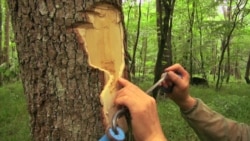Scientists are pitting insects against insects in a battle to control an invasive species.
U.S. Department of Agriculture researchers have released tiny parasitic wasps in forests in Maryland to attack the emerald ash borer, an invader from China that is devastating forests across the northern United States.
By the end of this decade, this insect will have done an estimated $10 billion of damage nationwide, according to one study.
Plant and animal hitchhikers traversing the planet in our globalized economy have made invasive species a $1.4 trillion-a-year problem worldwide, says the United Nations.
But rather than spraying pesticides that risk doing additional harm, the USDA scientists are bringing the invasive insect’s natural predators in from Asia to try to restore balance.
Forests at risk
Beneath the bark of an infested ash tree, the borer’s larvae carve twisting paths that cut off the supply of nutrients. It’s like slashing the tree’s arteries.
"There is a possibility some species may be completely wiped out by this beetle,” said USDA entomologist Jian Duan. “And you can imagine the cascading effect of losing a tree species in our native forest."
Ash trees make up 20 to 40 percent of some northern U.S. forests. The emerald ash borer threatens them and all the creatures that depend on them.
When the borer arrived from China in the 1990s - likely in a wooden crate or shipping pallet - it had no natural enemies here.
Consorting with the enemy
In Asia, several species of parasitic wasps lay their own eggs inside borers’ eggs. The young wasps steal the developing borer's food, and the borer dies. Other wasps lay eggs in the larva itself. The eggs hatch and eat the larva alive as they grow.
It’s a grizzly but effective way to keep the emerald ash borer’s population in check.
So Duan is introducing these wasps to forests under attack.
Wasps are used successfully to control cassava mealybugs in Africa and many other invasive pests.
Quarantine
But Duan knows that fighting an invasive insect with another import can be risky. It could become invasive, too.
So his lab raises wasps in quarantine while they're tested. He will only release picky eaters: wasps that would much rather attack an emerald ash borer than a native insect.
So far, Duan’s team has released three species of wasps. There are early signs that they are helping to slow the emerald ash borer’s advance. But they have a big job ahead of them.
While they have released several thousand wasps, one infested tree can produce hundreds of emerald ash borers. “It's really a drop in the ocean," Duan said.
"You have to think long-term,” he added.
Now Duan and his team will watch and wait to see if the wasps can return some balance to an ecosystem at risk.






